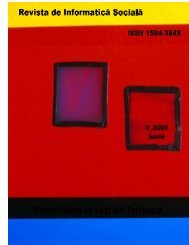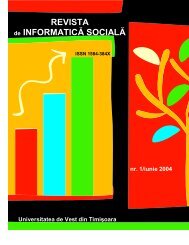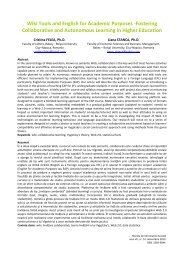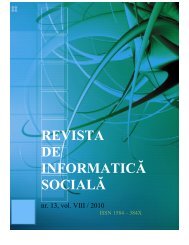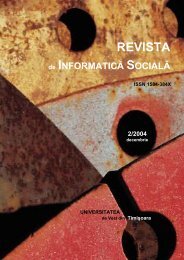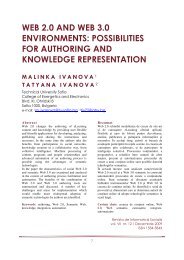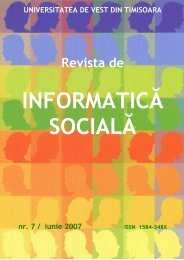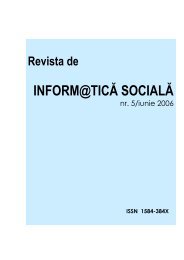It will be possible for institutions to learn from emerging best practices and skip stages <strong>of</strong> evolution.In particular, institutions that aggressively practice online, blen<strong>de</strong>d and e-learning at Stage I canraise their sights and transform their practices to make a jump shift to Stages III and IV, with furtherevolution to Stage V and the ad<strong>de</strong>d-value there for learners, job-seekers and employers. Such leapscould become feasible with strong campus-level lea<strong>de</strong>rship, recognizing the strategic potential <strong>of</strong>online learning.MULTI-FACETED EVOLUTION OF OPEN KNOWLEDGEJust as content and learning are evolving from “institutional” to “open,” knowledge is un<strong>de</strong>rgoingits own evolution on two dimensions. First, the 2.0 world <strong>of</strong> knowledge is changing thepredominant focus from knowledge as a “thing” or a “stock” <strong>of</strong> carefully marshaled, explicitknowledge resources in repositories, to knowledge as a “flow,” captured through conversations andinteractions with communities. Second, while traditional, <strong>de</strong>gree-based learning experiences haveprovi<strong>de</strong>d carefully drawn “knowledge paths” (sadly including paths that result in high levels <strong>of</strong>graduate unemployment), the 2.0 world is favoring learning that fills specific “knowledge gaps”(including gaps that correspond to employment opportunities that become more apparent throughdiscussions in Web 2.0-based networks). These two vectors <strong>of</strong> evolution will accelerate theemergence <strong>of</strong> Stage V in the evolution <strong>of</strong> online learning.In the January/February 2010 article in the EDUCAUSE Review, “Innovating the 21st CenturyUniversity,” Tapscott and Williams [18] discussed the powerful potential <strong>of</strong> collaborativeknowledge production to open up the university to a re-invented pedagogy <strong>of</strong> open, social, selfpacedlearning where faculty and learners collaborate to co-create knowledge. This is an importantinsight. Yet they failed to clearly articulate two other, critical insights. First, the essentialdifferences between the requirements for knowledge pathways and knowledge gaps/flows. Second,the potential for an increasing emphasis on gaps/flows to transform the balance <strong>of</strong> power in 21stCentury learning and competence building away from traditional approaches to higher education,towards new approaches that meet emerging needs.From Knowledge Stocks to Knowledge FlowsTransforming eKnowledge: A Revolution in Knowledge Sharing [<strong>14</strong>] discussed how knowledge isin a continuous state <strong>of</strong> re-invention, a flow <strong>of</strong> ongoing discovery culminating in the knowledgebeing easier to disseminate and appropriate, for example by being expressed in an explicit way insome knowledge store (repository, course, book, technical manual). It also <strong>de</strong>scribed how theubiquitous use <strong>of</strong> ICT and the emergence <strong>of</strong> Web 1.0 tools were changing the very ways in whichwe experience knowledge, accelerating the <strong>de</strong>mise <strong>of</strong> knowledge stocks and providing new meansfor individuals to participate in and co-create knowledge flows. This is truly about “TransformingeKnowing.”In “The Big Shift,” [21] Hagel and Brown argue that the combination <strong>of</strong> the Great Recession andWeb 2.0 is causing every industry to re-imagine its basic principles and practices. In the process, weare shifting from a world where classic forms <strong>of</strong> strategic advantage were protecting and extractingvalue from stable, existing knowledge stocks, to a world where the focus <strong>of</strong> value creation andproductivity enhancement is on effective participation in knowledge flows, which are continuouslyrenewed. These knowledge flows are created through communities <strong>of</strong> practice and social networkbasedcollaborative spaces in pr<strong>of</strong>essions, industries, commercial enterprises, civic andphilanthropic organizations and educational enterprises. Active, free-range learners can participatein these flows continuously, using the tools <strong>of</strong> the “eLifestyle” – from single <strong>de</strong>vices (such as smartphones and PDAs), to multiple-<strong>de</strong>vices-in-one-package (such as dual books combining an e-rea<strong>de</strong>rand a tablet computer) – and applying them to recreation, socializing personal business, work andlearning.
New communities, tools and services are emerging to tap knowledge flows and conversationsrelated to them. For example, the Knowledge Media Institute at the U.K. Open University hasestablished an open community for sense-making [18] and for discussing interpretations an<strong>de</strong>xperiences <strong>of</strong> using relevant tools for sense-making. The ascendance <strong>of</strong> such open knowledgeflows seems set to ren<strong>de</strong>r obsolete the institutionalized, course-based knowledge stocks that changeat the pace <strong>of</strong> curriculum committee review.From Following Knowledge Paths to Filling Knowledge GapsTraditional higher learning is <strong>of</strong>ten based on <strong>de</strong>fined learning paths, preor<strong>de</strong>red routes where theteacher passes knowledge to the stu<strong>de</strong>nts, who absorb it and try to apply it to their own pre-existingknowledge in the subject. These structured learning and knowledge paths have always worked bestin K-12 and in certificate and lower-division baccalaureate settings, where early stage learners needto complete a prescribed course <strong>of</strong> stu<strong>de</strong>nt study. But they are becoming far less attractive in theWeb 2.0 world <strong>of</strong> self-directed learning amidst rapidly changing knowledge flows.Most active adult learners are concerned with filling specific knowledge gaps, rapidly, and forimmediate application. In today’s group-based learning experiences, learners fill learning gaps by acombination <strong>of</strong> asking peers and using stored knowledge, intuition, problem solving, creativity andadaptability. Knowledge solutions are created and shared by the group. Learning gaps will becomethe primary focus <strong>of</strong> online learning experiences, where faculty members become brain trainers, notpurveyors <strong>of</strong> one-to-many training on a prescribed stock <strong>of</strong> knowledge achieved in an or<strong>de</strong>redpathway. Knowledge gap-focused learning, fueled by constantly changing knowledge flows, willsoon be recognized as the new gold standard for 21st century learning and competence building.Leveraging Pathways and Gaps in CombinationThe interplay and competition between traditional knowledge pathways and knowledge flows/gapsbasedlearning is not some coming conflict that will be played out in the distant future. It ishappening today. Consi<strong>de</strong>r the example <strong>of</strong> the competence gaps that most employers complain arelacking in many current graduates: advanced communication competence – both written and verbal;<strong>de</strong>monstrated capacity to thrive in team-centered, problem-solving settings; experience and facilityin innovation, entrepreneurship, and serving as a free agent in creating personal opportunities; andthe habits <strong>of</strong> mind, body and spirit to be perpetual learners – lifelong and all the time. One wouldhope that achieving these competences could be embed<strong>de</strong>d in all learning pathways purporting toprepare learners for success in the 21st Century.A quicker, surer way is to create community-based experiences that immerse learners in ways thatenable them to <strong>de</strong>velop and <strong>de</strong>monstrate these competences. These knowledge-gap-focusedcommunity experiences can occur at the same time learners are engaged in their traditionalknowledge pathways. We are working with partnerships <strong>of</strong> universities, employers, Ministries <strong>of</strong>Education, and citizens across the world to <strong>de</strong>velop such experiences and make them availableconcurrently with knowledge pathways.SUMMARY/CONCLUSIONSFor the past 15 years, American higher education has been evolving the technologies, tools andpractices that have become the instruments for transformation, and perhaps disruption. Our currentand future financial crisis leaves no viable option than transforming to discover financialsustainability in “The New <strong>No</strong>rmal.” The time has come for American higher education lea<strong>de</strong>rs tolearn from innovators globally – to both get serious and strategic about the coming disruptions andthe need to re-imagine PK-20 education, workforce training and competence <strong>de</strong>velopment for therealities <strong>of</strong> the post-recession 21st Century.
- Page 1: Revista de Informatica Sociala 14 /
- Page 7: ● ● ●CONTENTS● ● ●[9-20
- Page 10 and 11: THE TRANSITION FROM OLD TO NEW MEDI
- Page 12 and 13: 30252023.420.325.11510500.85.5Never
- Page 14 and 15: Overall, we can therefore sum up on
- Page 16 and 17: n.a.I often use itI seldom use it6.
- Page 18 and 19: - Traditional web use: searching th
- Page 20 and 21: 19. Kvavik R.B., Caruso J.B. and Mo
- Page 22: IntroductionIn 1995, Bernie Dodge o
- Page 25 and 26: The Web-Inquiry Project [WIP] is a
- Page 27 and 28: and even orally. The teacher will a
- Page 29 and 30: environment in which the teacher gu
- Page 31 and 32: Transformation Through Online Learn
- Page 33 and 34: INTRODUCTIONLeading practitioners a
- Page 35 and 36: learning. We also describe how the
- Page 37 and 38: Some of these transformations are b
- Page 39 and 40: Recently, Twigg has received suppor
- Page 41 and 42: Stage III: Unbundled Learning, Mark
- Page 43 and 44: perhaps using Second Life-like virt
- Page 45 and 46: performance. Indeed, Stage V will l
- Page 47: Free-Range Open LearningOver time,
- Page 51 and 52: Embed enterprise-wide predictive an
- Page 53 and 54: In collaboration with Strategic Ini
- Page 55 and 56: Wiki Tools and English for Academic
- Page 57 and 58: eality. Besides being an additional
- Page 59 and 60: StudentPage 1StudentPage nTeacher
- Page 61 and 62: 100%90%80%70%60%50%40%30%20%10%0%Ac
- Page 63 and 64: 200Correlation View/Page Edits150Vi
- Page 65 and 66: 14. http://eacea.ec.europa.eu/llp/s
- Page 67 and 68: Simularea şi comunicarea electroni
- Page 69 and 70: RespondenţiRăspunsuriLa nivelul
- Page 71 and 72: RespondenţiRăspunsuriLa nivelul
- Page 73 and 74: Respondenţii au fost rugaţi să i
- Page 75 and 76: Itemul 9 doreşte să identifice ti
- Page 77 and 78: Identificara opţiunii, chiar şi p
- Page 79 and 80: EşantioaneRăspunsuri/Ranguriagita
- Page 81 and 82: modalităţile practice prin care u
- Page 83 and 84: 1. INTRODUCEREÎn prezent, complexi
- Page 85 and 86: Figura 1. Analiza grafică a evolu
- Page 87 and 88: Faţă de această situaţie se deg
- Page 89 and 90: variabilele acesti noi culturi cybe
- Page 91 and 92: INTRODUCEREÎncă din anul 2000 am
- Page 93 and 94: după tipul lecţiei: prezentare de
- Page 95 and 96: Funcţiile oferite de AEL asigură
- Page 97 and 98: • elevi/studenţi, beneficiari di
- Page 99 and 100:
Se poate folosi cadrul formal de co
- Page 102 and 103:
Evaluarea formativă este comentari
- Page 104 and 105:
Rezultatele elevilor, pe itemi:Diag
- Page 106 and 107:
Nr. Denumirea activităţii AEL MOO
- Page 108 and 109:
SEMNAL EDITORIALLaura MALITA, Vanna
- Page 110:
IN MEMORIAMConstantin TraianCHEVERE



